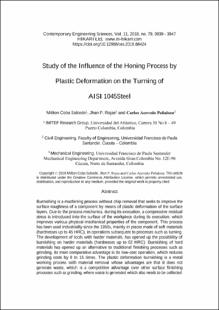Study of the influence of the honing process by plastic deformation on the turning of AISI 1045steel
...
Coba Salcedo, Milton Fabian | 2018-09-18
Burnishing is a machining process without chip removal that seeks to improve the
surface roughness of a component by means of plastic deformation of the surface
layers. Due to the process mechanics, during its execution, a compressive residual
stress is introduced into the surface of the workpiece during its execution, which
improves various physical-mechanical properties of the component. This process
has been used industrially since the 1950s, mainly in pieces made of soft materials
(hardnesses up to 45 HRC), in operations subsequent to processes such as turning.
The development of tools with harder materials, has opened up the possibility of
burnishing on harder materials (hardnesses up to 62 HRC). Burnishing of hard
materials has opened up an alternative to traditional finishing processes such as
grinding, its main comparative advantage is its low-cost operation, which reduces
grinding costs by 8 to 15 times. The plastic deformation burnishing is a metal
working process with material removal whose advantages are that it does not
generate waste, which is a competitive advantage over other surface finishing
processes such as grinding, where waste is generated which also needs to be collected and subsequently treated. The use of e.g. coolants is not necessary either, in recent
years, attempts have been made to eliminate them from material working processes,
because their presence not only causes a significant cost that impacts the
manufacturing process, also represents an environmental problem due to its
polluting effect, with the associated management costs involved. This article
presents the results of an AISI 1045 test specimen experiment, to which a turning
process has previously been carried out.
LEER










